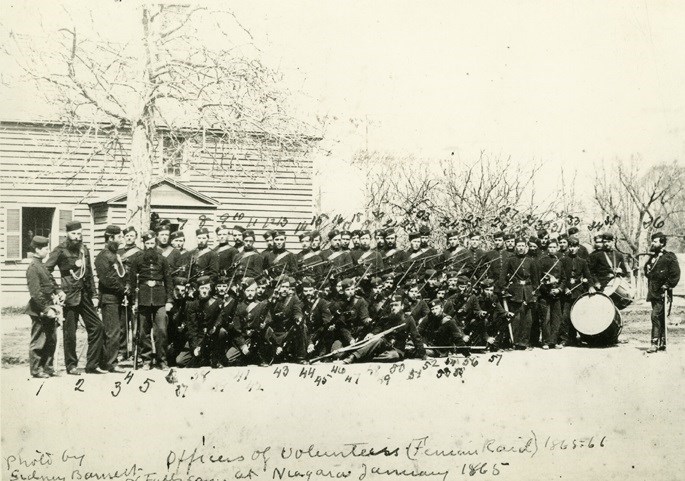From the archives of the Sault Ste. Marie Public Library:
*************************
Remember This . . . Thomas Andrew Paton Towers
One of the city’s early residents led an exciting, adventure-filled life, with much of it spent in the military. Thomas Andrew Paton Towers was born in Edinburgh, Scotland on November 19th, 1841, the son of Walter Towers and Agnes Paton. Unfortunately his father died when Thomas was only six months old, so his uncle, Thomas Paton, a surgeon with the army in India took over the direction of his education.
Thomas began attending Mr. Oliphant’s School in Edinburgh on May 15th, 1848 and then moved on to attend the Edinburgh Institute in 1853. While at the Edinburgh University, his education was directed towards the East Indian Company’s service. He attended university with Prince Edward, who would later become King of England and it is recorded that he was actually part of the racing crew for Prince Edward’s yacht.
Like many of the young men of this era, when he completed his university education he went on a tour of Europe. It was expected that he would then make his way to India to take up his role in the East Indian Company, however Thomas Towers decided that he would rather travel to Canada. Travelling on the high seas at this time was often quite dangerous and as Thomas’ ship neared the coast of Canada, they were shipwrecked off the coast of Newfoundland. Fortunately he survived this adventure and made his way back to Scotland. Undeterred by this setback, he once again set off for Canada in 1861.
He made his way to Montreal and while there he met his future wife, Helen Davidson, daughter of John and Margaret Davidson. The couple settled in Sault Ste. Marie and eventually had six daughters and two sons, although one son, Walter died at age of 16. The Towers’ family home was located at 157 Pim Street. Thomas Towers was posted to the Sault Ste. Marie Half Battery of Mountain Artillery as a lieutenant. While in this position, he participated in the Fenian Raids of 1866. The Fenians, described as a “large number of Irish agitators” who had settled in the United States wanted to invade Canada and take the country away from England and they were very surprised when they were met with resistance from Canadians!
The news that 400 Fenians were in Marquette, Michigan and could be on their way to Sault Ste. Marie led Captain Wilson, Lieutenant Prince and Ensign Towers to lead a group of 52 volunteers and place them under arms on June 6, 1866. They took up a position on the river beach in front of Marchbank, the Wilson residence which was located on the northwest corner of Bay and March Streets and this company kept watch for thirteen days. In the Annals of Sault Ste. Marie by Edward Capp, it was reported that during the first two days the “town was repeatedly startled by the booming of cannon, and it was found that Americans who were working at Pointe aux Pins, and who had come from Detroit, were discharging a field piece from time to time in order to create a sensation.” A squad of men were sent to the area and they seized the gun and brought it to Sault Ste. Marie. On another night shots were fired from the river at the sentry on duty with a bullet actually going right through his cap. There continued to be more threats and false alarms but by June 19, the Fenian threat was over and the company of volunteers were disbanded and sent home again.
In 1870 he was put in charge of the voyageurs of the Red River Expedition under Lord Wolseley. He was also the assistant superintendent of the Red River Route and then took over the management of a transportation company between Lake Teslin, located between the Yukon-British Columbia border and Dawson City. Thomas Towers received a silver general service medal for his role in the Fenian Raid and in the Red River Expedition in 1870.
Captain Thomas Towers was selected to address citizens at the turning of the first sod for the Canadian Pacific Railway on June 1st, 1875 at Prince Arthur’s Landing (Port Arthur), now part of Thunder Bay. He was thrilled to see the connecting railway link from the west to the water link provided by the Great Lakes and knew that it would be an important link for the future of the country.
On July 9, 1878, Thomas was appointed clerk of the district court at Sault Ste. Marie. He continued to travel extensively throughout the district and took a great interest in the mining and spent a lot of his later years trying to interest others in the wealth of mines in the district.
In 1901, Captain Thomas Andrew Paton Towers received a Colonial Auxiliary Forces Officers Decoration. Queen Victoria created this decoration to recognize long service in the Australian and Canadian forces and it became known as the VD. After a full and adventurous life, Thomas died on November 23rd, 1913 and was buried in the Queen Street East Cemetery. In Edward Capp’s book, he describes Thomas as “one of the early settlers whose quiet tenacity helped to anchor Sault Ste. Marie to the older civilization and thus lead to greater things.”
*************************
Each week, the Sault Ste. Marie Public Library and its Archives provides SooToday readers with a glimpse of the city’s past.
Find out more of what the Public Library has to offer at www.ssmpl.ca and look for more Remember This? columns here
